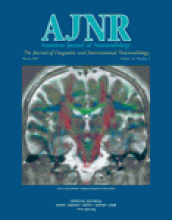Abstract
BACKGROUND AND PURPOSE: Diffusion- (DW) and perfusion-weighted (PW) MR imaging reflect neurophysiologic changes during stroke evolution. We sought to determine parameters that distinguish regions of brain destined for infarction from those that will survive despite hypoperfusion.
METHODS: DW and PW images were obtained in 30 patients at 1–12 hours after symptom onset. Relative cerebral blood volume (rCBV), flow (rCBF), mean transit time (MTT), apparent diffusion coefficient (ADC), DW image signal intensity, and fractional anisotropy (FA) lesion-contralateral normal region ratios were obtained in the following regions: 1) infarct core with hyperintensity on DW image, abnormality on rCBF and MTT images, and follow-up abnormality; 2) infarcted penumbra with normal DW image, abnormal rCBF and MTT images, and follow-up abnormality; and 3) hypoperfused tissue that remained viable, with normal DW image, abnormal rCBF and MTT images, and normal follow-up.
RESULTS: rCBF ratios for regions 1, 2, and 3 were 0.32 ± 0.11, 0.46 ± 0.13, and 0.58 ± 0.12, respectively, and were significantly different. DW image intensity and ADC ratios were significantly different among all regions, but were more similar than rCBF ratios. rCBV and FA ratios were not significantly different between regions 2 and 3. No MTT ratios were significantly different. No region of interest with an rCBF ratio less than 0.36, an rCBV ratio less than 0.53, an ADC ratio less than 0.85, a DW image intensity ratio greater than 1.23, or an FA ratio greater than 1.10 remained viable. No region of interest with an rCBF ratio greater than 0.79 infarcted.
CONCLUSIONS: Differences among mean ratios of three regions investigated were greatest for the rCBF ratio. The rCBF ratio may be the most useful parameter in differentiating viable tissue that is likely to infarct without intervention, from tissue that will survive despite hypoperfusion. ADC, DW intensity, FA, and rCBV ratios may provide adjunctive information.
- Copyright © American Society of Neuroradiology












